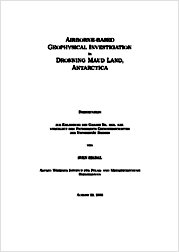| dc.contributor.author | Riedel, Sven | |
| dc.date.accessioned | 2010-10-12T19:28:08Z | |
| dc.date.available | 2010-10-12T19:28:08Z | |
| dc.date.issued | 2008 | |
| dc.identifier.uri | http://hdl.handle.net/11858/00-1735-0000-0001-318F-2 | |
| dc.description.abstract | Antarctica represents a key component in the investigation of the geological history and reconstruction of the supercontinents Rodinia and Gondwana. Remnants of the formation and disintegration of these former land masses can be found, although great uncertainties remain in the location of tectonic boundaries beneath the ice sheet of Antarctica due to general lack of outcrops and the limited amount of geological data. Space and airborne measurements are the only possibility to obtain comprehensive spatial data coverage of geophysical data over the extensive large polar areas. Common knowledge of the geological framework displays three major tectonic events which formed Dronning Maud Land (DML): the Grenvillian Orogen (1.1 Ga) build up Rodinia, the Pan-African-Antarctic Orogen (EAAO, 500 Ma) rose in the supercontinent Gondwana and finally the breakup of Gondwanaland, at around 180 Ma... | |
| dc.format.extent | 174 S. | |
| dc.format.mimetype | application/pdf | |
| dc.language.iso | eng | |
| dc.publisher | Univ. Bremen | |
| dc.rights.uri | http://e-docs.geo-leo.de/rights | |
| dc.subject.ddc | 526.7 | |
| dc.subject.ddc | 559 | |
| dc.subject.ddc | 538.87 | |
| dc.subject.ddc | 550 | |
| dc.subject.gok | TSY 200 | |
| dc.title | Airborne-based geophysical investigation in Dronning Maud Land, Antarctica | |
| dc.type | monograph | |
| dc.subject.gokverbal | Antarktis {Geophysik} | |
| dc.subject.gokverbal | Aerogeophysik | |
| dc.identifier.doi | 10.23689/fidgeo-261 | |
| dc.identifier.ppn | 599300604 | |
| dc.identifier.urn | urn:nbn:de:gbv:46-diss000113400 | |
| dc.type.version | publishedVersion | |
| dc.relation.collection | Geophysik | |
| dc.description.type | thesis | |


